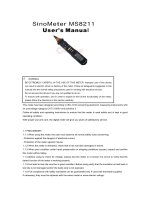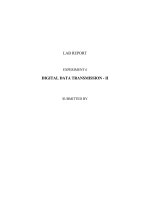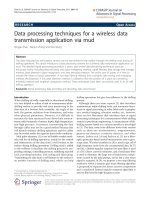DIGITAL DATA TRANSMISSION - I
Bạn đang xem bản rút gọn của tài liệu. Xem và tải ngay bản đầy đủ của tài liệu tại đây (102.42 KB, 14 trang )
EE-458 LAB REPORT
EXPERIMENT #5
DIGITAL DATA TRANSMISSION - I
1/27/2010
Page 2
Purpose:
The objectives of this laboratory are:
1. To implement baseband, amplitude shift keying, and phase reversal keying for binary
communication systems.
2. To investigate the operation of these systems.
3. To measure the effects of noise on the probability of error in the received data.
Equipment List
1. PC with Matlab and Simulink
Page 3
Digital Modulation Techniques
There are three ways in which the bandwidth of the channel carrier may be altered
simply. It is worth emphasizing that these methods are chosen because they are practically
simple, not because they are theoretically desirable. These are the altering of the amplitude,
frequency and phase of the carrier sine wave. These techniques give rise to amplitude-shift-
keying (ASK), frequency-shift-keying (FSK) and phase-shift-keying (PSK), respectively.
ASK describes the technique the carrier wave is multiplied by the digital signal f(t).
Mathematically, the modulated carrier signal is s(t):
Figure: Amplitude shift keying
Figure: Amplitude shift keying -- frequency domain
The pulses representing the sample values of a PCM waveform can be transmitted on a RF
carrier by use of amplitude, phase or frequency modulation. For digital amplitude
modulation, it is known as Amplitude Shift Keying. Here, the carrier amplitude is determined
by the data bit for that interval. We note that the transmitter for such a system simply consists
of an oscillator that is gated on and off; accordingly, ASK is often referred to as on-off
keying. The oscillator runs continuously as the on-off gating is carried out.
The circuit is connected according to the schematic shown. A silicon diode and a 50-ohm
terminator are also used. The VCO generates a 20 kHz carrier signal and receiver reference.
The summer and variable power supply changes the threshold of the decision circuit.
Threshold Adjustment:
Page 4
The output of the integrator has values between zero volts and “A” volts. The threshold
voltage is selected to be +A/2 volts. In other words, the output of the decision summer should
be –A/2 (“0”) and +A/2 (“1”). This can be easily done if the output of the summer with the
DC supply is viewed on the scope. The Dc level is adjusted until the square wave waveform
is centered about 0 volts. The limiter converts this to ±2.5V.
PSK describes the modulation technique that alters the phase of the carrier. Mathematically:
Phase Shift Keying
The pulses representing the sample values of PCM waveform when transmitted using phase
modulation, Phase Shift Keying occurs. Here, the data bit establishes the phase of the carrier.
Removing the diode from the ASK modulator results in phase shift keying modulation (PSK).
The threshold voltage is returned to 0V. The PSK signal is observed using the oscilloscope as
it is generated and detected.
Page 5
Laboratory Procedure
A) Base band Transmission:
The circuit is built according to the schematic shown in figure 5A. The data rate (fs) is set for
5 kHz. The Frequency counter is set to DC coupling and the auto level is set to OFF. The
module is monitored using the oscilloscope.
Figure 5 A (a) Base Band transmission
The functions of the different modules are explained below:
Digital Signal Source:
The signal sources produce a series of “0”s (about –2.5 V) and “1”s (+2.5 V) at the data rate
set by the Master Clock. The time period of each bit is T = 1/fs. This signal is useful in
visually examining the detection process. This signal is useful in accurately measuring errors
in detected data due to a communications channel.
Figure 5 A (b) Block parameters digital signal source
Summer:









